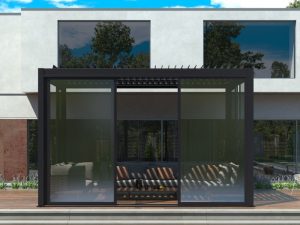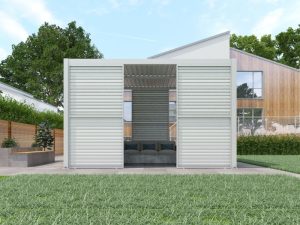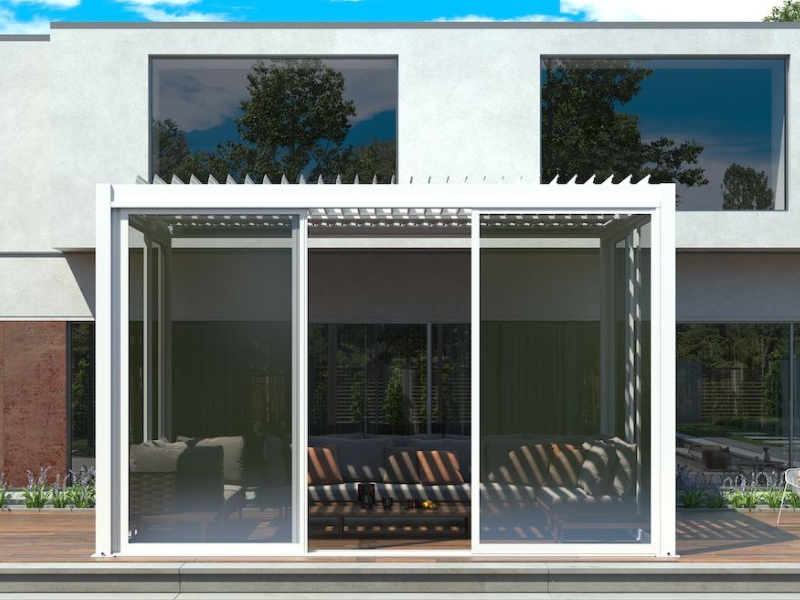A pergola area can still shine in winter — but only if you adapt it for the season. Without the right tweaks, your space might sit unused as temperatures drop and the wind whistles through. The solution lies in understanding where your current setup falls short and what you can adjust for better comfort, safety, and function. From smarter heating to weatherproofing, this guide shows you how to make your pergola a truly year-round feature. Read on to uncover common winter hurdles — and how to work around them without breaking the bank.
What challenges make a pergola area less usable in winter?
A winter-ready pergola has to do more than look good — it must stand up to weather, temperature swings, and reduced daylight. Many pergolas fall short once the cold sets in. Here are the most common challenges that affect winter comfort:
- Cold wind exposure: Even light breezes can cut through an open pergola and chill the space quickly, making it hard to relax or entertain.
- Excess moisture and mildew risk: Winter often brings more rain and dew, which linger on surfaces and cushions, leading to mould and unpleasant smells.
- Open roofs let weather in: Slatted designs might look stylish, but they offer little protection from rain or frost unless combined with overhead panels.
- Lack of functional lighting: Shorter days mean you’ll rely more on artificial lighting. If your pergola doesn’t have enough shade, it becomes unusable by late afternoon.
These issues can make even a beautiful pergola feel unwelcoming. Tackling exposure and drainage early keeps your outdoor space in use year-round.
Why do some materials fail to perform during cold seasons?
Not all building materials handle cold, damp conditions well. Some begin to fail just when you need them most. Here are the key material performance issues to watch for:
- Swelling and warping in timber: Natural timber absorbs moisture, causing movement in joints and framing. This warping can throw off rooflines and make covers hard to attach.
- Cracking or splitting in softwoods: Softwoods like pine may not cope with fluctuating temperatures unless sealed regularly. Cracks form, allowing more water in, which speeds up decay.
- Rust in untreated steel: Without powder coating or galvanising, steel posts and fixtures can rust quickly in winter damp, weakening the structure.
- Brittle synthetic fabrics: Thin roof covers and curtains may harden and crack on frosty mornings, becoming fragile with repeated exposure.
If you’re planning the layout around a pergola space, choosing hardy materials up front saves you headaches later. Low-maintenance options like aluminium or composite timbers often perform better through seasonal shifts.
How does winter weather affect pergola usage and safety?
Even if you’re willing to brave the cold, a poorly adapted pergola can pose risks that go beyond discomfort. Here are the main safety and usability concerns for winter:

- Slippery walking surfaces: Decking, tiles, or concrete can become slick with moisture. This increases the chance of falls, especially for children or older people.
- Electrical risks from dampness: Any exposed fittings or light sockets need sealing to prevent shocks or short circuits from condensation.
- Poor heater placement: Gas heaters need open airflow — placing them in tight, enclosed areas without ventilation is unsafe.
- Frost damage to finishes: Repeated freeze-thaw cycles wear down paints, seals, and even anchor bolts, reducing their lifespan.
You’ll improve safety and longevity by following steps to protect outdoor structures from the weather. It doesn’t require major renovation — just smarter planning and routine maintenance.
What heating options work best in a pergola area?
Winter heating is all about targeting warmth where you need it without wasting energy. Some options are better suited to pergolas than others. Here are the most effective heating solutions for outdoor areas:
-
- Radiant electric heaters: These emit infrared heat that warms people and surfaces directly. Ideal for covered pergolas with low airflow.
- Mounted heaters on posts or beams: Wall or ceiling-mounted units stay out of the way and distribute heat evenly across a seating zone.
- Gas patio heaters: Portable and powerful, they work well in open pergolas, as long as the area is ventilated properly.
- Enclosed pergola accessories: If your pergola includes features like motorised louvers or glass sliding doors, fixed radiant heaters can help create a consistent, enclosed heat zone for sustained comfort.
- Fire pits or braziers: They offer both warmth and visual appeal but require fire-safe ground materials and adequate clearance.
The key is focusing on sustained comfort, not quick fixes. If you’re considering long-term improvements, try designing a cosy pergola area for colder months with built-in heat solutions that align with your layout.
How can design help create a winter-friendly pergola space?
You don’t have to start from scratch — even small design changes can improve warmth, light, and usability during the cooler months. Here are the most impactful design enhancements for winter comfort:
- Weather barriers with style: Clear PVC blinds or sliding screens stop wind and rain while maintaining views. These reduce heat loss without blocking natural light. For homeowners considering enclosure options, understanding how glazed glass doors improve comfort and efficiency can help you choose features that enhance both usability and aesthetics during colder months.
- Roof upgrades for insulation: Installing polycarbonate panels or retractable canopies provides better shelter from rain and frost, and often improves acoustics, too.
- Layered lighting for dark evenings: Add overhead lights, warm-toned fairy lights, and floor-level path markers to keep the area functional after sundown.
- Insulating décor: Thick outdoor rugs and padded cushions create a cosier feel and help retain body heat on seats and floors.
| Upgrade Option | Winter Benefit | Year-Round Bonus |
| PVC blinds | Wind control and rain protection | Keeps bugs out in warmer months |
| Polycarbonate roofing | Insulates from cold and damp | Reduces glare and UV in summer |
| Layered lighting | Prevents dark, unusable evenings | Adds atmosphere for any occasion |
| Insulated floor rugs | Warmer underfoot surfaces | Visual interest + seasonal texture |
Are there cost-effective ways to upgrade for winter comfort?
Winter prep doesn’t need a huge budget — with the right choices, you can increase warmth and weather resistance without blowing the bank. Here are some affordable upgrade ideas to try:

- Heavy outdoor curtains: These provide flexible protection from rain or wind and can be pulled aside in warmer weather, making them a year-round solution.
- Under-roof insulation panels: Adding insulation under existing pergola roofs limits heat loss without altering the appearance or needing complex installation.
- Thermal covers for furniture: Swap out light cotton for heavier, water-resistant covers that add warmth and withstand moisture throughout the season.
- Solar-powered LED lighting: Easy to install and cheap to run, solar lights improve usability during darker winter evenings with little effort.
For those using gas heaters, it’s worth understanding the safe use of outdoor gas heaters in colder months to ensure warmth without compromising safety.
Make your pergola area winter-ready with smart choices
Making your pergola winter-ready doesn’t mean starting over. The key is adapting your existing layout to resist the elements while improving comfort. That could mean sealing off exposed sides, upgrading lighting, or rethinking where your heater sits. Look at where the wind comes through, what gets wet, and where you feel the chill first, then make changes that address those pain points directly. When planned right, even the coldest night becomes a reason to linger outside. For a tailored walkthrough of your outdoor setup, you can explore backyard options with Unique Pergolas.


